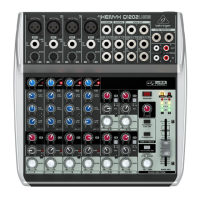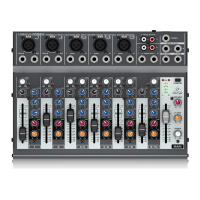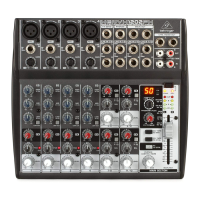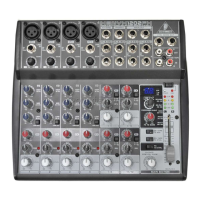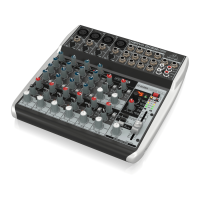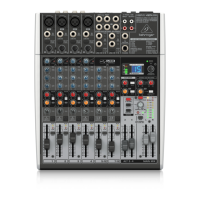6
XENYX
502/802/1002/1202
2.1.2 Equalizer
All mono input channels include a 3-band equalizer, except for
the 502, which is equipped with a 2-band EQ. All bands provide
boost or cut of up to 15 dB. In the central position, the equalizer
is inactive.
The circuitry of the British EQs is based on the technology
used in the best-known top-of-the-line consoles and providing a
warm sound without any unwanted side effects. The result are
extremely musical equalizers which, unlike simple equalizers,
cause no side effects such as phase shifting or bandwidth
limitation, even with extreme gain settings of ±15 dB.
Fig. 2.2: The equalizer of the mono input channels
EQ
The upper (HI) and the lower band (LO) are shelving filters
that increase or decrease all frequencies above or below their
cut-off frequency. The cut-off frequencies of the upper and
lower band are 12 kHz and 80Hz respectively. The mid band
(802/1002/1202) is configured as a peak filter with a center
frequency of 2.5 kHz.
LOW CUT
In addition, the mono channels (1002 and 1202) are equipped
with a steep LOW CUT filter (slope at 18 dB/oct., -3 dB at 75 Hz)
designed to eliminate unwanted low-frequency signal
components.
2.1.3 FX sends, panorama and level adjustment
Fig. 2.3: The FX send/panorama/level controls
FX (802/1002/1202 only)
FX sends (or AUX sends) enable you to feed signals via a
variable control from one or more channels and sum these signals
to a bus. The bus appears at the consoles FX send output and
can be fed from there to an external effects device. The return
from the effects unit is then brought back into the console on the
aux return connectors (802) or normal channel inputs. Each FX
send is mono and features up to +15 dB gain.
As the name suggests, the FX sends of the XENYX mixing
consoles are intended to drive effects devices (reverb, delay,
etc) and are therefore configured post-fader. This means that
the mix between dry signal and effect remains at the level
determined by the channels aux send, irrespective of the channel
fader setting. If this were not the case, the effects signal of the
channel would remain audible even when the fader is lowered
to zero.
PA N
The PAN control determines the position of the channel signal
within the stereo image. This control features a constant-power
characteristic, which means the signal is always maintained at a
constant level, irrespective of position in the stereo panorama.
LEVEL
The LEVEL control determines the level of the channel signal
in the main mix.
CLIP
The CLIP LEDs of the mono channels illuminate when the
input signal is driven too high, which could cause distortion. If
this happens, use the TRIM control to reduce the preamp level
until the LED does not light anymore.
2.2 Stereo channels
2.2.1 Stereo line inputs
Fig. 2.4: Stereo line inputs
LINE IN
Each stereo channel has two balanced line level inputs on 1/4"
jacks for left and right channels. If only the jack marked L (left)
is used, the channel operates in mono. The stereo channels are
designed to handle typical line level signals.
Both inputs will also accept unbalanced jacks.
2.2.2 Equalizer stereo channels (802)
The XENYX 802 features a stereo 3-band EQ in each stereo
channel. The filter characteristics and cut-off frequencies are
the same as those in the mono channels.
Fig. 2.5: The equalizer of the stereo input channels
A stereo EQ is highly preferable to two mono equalizers. when
working on a stereo signal, as two separate EQs will usually produce
an unwanted discrepancy between the left and right channels.
2.2.3 FX sends, balance and level adjustment
Fig. 2.6: The FX send/balance/level controls
2. CONTROL ELEMENTS AND CONNECTORS

